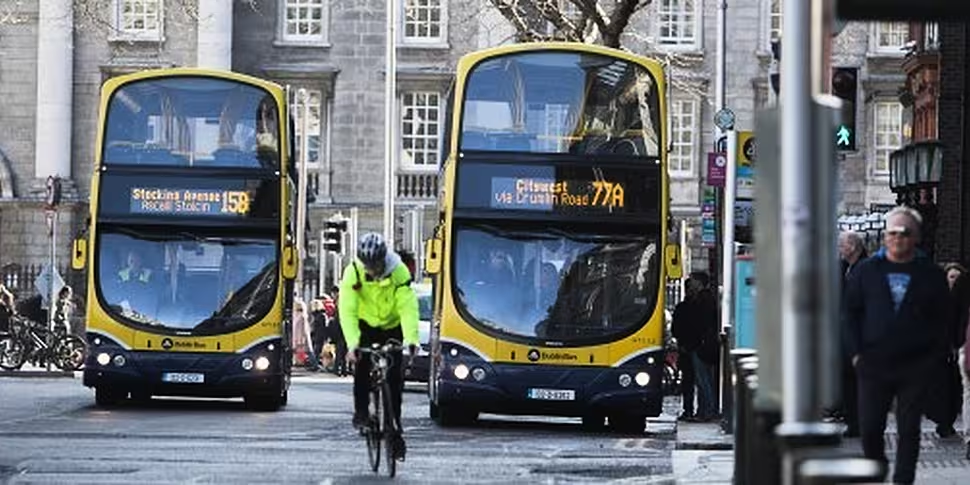Plans have been unveiled for a new cashless system for journeys on Dublin Bus.
It is part of a new BusConnects strategy, which will see a radical transformation of public transport in the capital.
The new system will also streamline paying for bus journeys.
This will see a move to either a 'tag-on' and 'tag-off' facility - similar to Luas and DART - or a single 'flat fare' approach.
Cashless operation will be introduced on all buses, to remove the delays caused by cash payments. Currently, over 70% of fare payments are made by Leap Card.
The National Transport Authority (NTA) say: "As this increases over the next couple of years, the transition to a cashless regime will become easier."
The NTA say this will potentially allow the use of credit/debit cards or mobile devices as a means of payment.
Commuters can also integrate this with other transport payments - such as parking facilities and bicycle hire.
The NTA say this system should be in place "in the next few years".
New BRT model | Image: NTA
Bus Rapid Transit
It will also see the introduction of new rapid buses for the capital.
The new buses will have several doors, higher platforms for level boarding and stops that are spaced further apart than those that serve conventional buses.
The NTA say a Bus Rapid Transit (BRT) can cater for a higher volume of passengers than a normal bus corridor.
Image: NTA
New corridors
A new network of bus corridors will form the 'Core Bus Network' for the Dublin region.
There are eleven radial bus corridors planned in addition to the BRT routes, as well as three orbital bus corridors.
The NTA say: "Our objective is to develop these eleven radial bus corridors and three orbital bus corridors so that each will have continuous bus priority - in other words, a continuous bus lane in each direction.
"This 'next generation' of bus corridors will deliver a transformation in the performance of these routes, making it easier and quicker for you to come and go by bus".
On each of the corridors, there will also be high-quality cycling facilities - segregated from the bus lanes and general traffic lanes as far as is practicable.
Low emission vehicles
While a decision on the optimum fleet technology will be made by the end of this year. It will see either a single technology or a combination used.
A transition plan will see the bus fleet move to low emission vehicle types, with the first going into service during 2018.
By 2023, half of the bus fleet - approximately 500 buses - will be converted to low emission vehicles.
The National Transport Authority say full conversion will be completed by 2030.
Image: NTA
Park and Ride
A network of park and ride facilities will also be developed at key locations.
A high-frequency bus service will run at each location, while parking charges and bus fares will be integrated.
A new style of bus stop is to be rolled out across all bus stops in the city, with better route and fare information provided in each case.
More Real Time Passenger Information (RTPI) signs along the new bus corridors and elsewhere will also be introduced.
And bus shelters will be significantly expanded as part of the BusConnects plan.
This map shows the current bus network (high-frequency routes only) | Image: NTA
Anne Graham, NTA CEO, said: "We believe that there is potential to increase bus passenger numbers by at least 50% over the lifetime of the project, which would represent a significant step-change in how people get from place to place.
"This can only happen if measures are put in place to make bus travel more convenient, more reliable and more appealing and we believe that BusConnects will do precisely that."
The total cost of the plan is estimated to be over €1b, some €300m of which is already committed under the 2015 Capital Plan.
A new-look bus stop | Image: NTA
NBRU forum
In response to the plans, NBRU General-Secretary Dermot O'Leary said: "Whilst we welcome the acknowledgement that the humble bus will remain the optimum public transport solution, it is of paramount importance that all issues associated with a successful transport operation, inclusive of commuter and staff concerns are fed in to any and all consultative processes.
"It is only two short years ago that we had a dispute across both Dublin Bus and Bus Éireann in relation to attempts by the Department of Transport and the NTA to force privatisation into CIÉ without recourse to staff concerns.
"Part of the resolution of this dispute was the recognition that employment conditions would require a Sectoral Employment Order (SEO) whereby there would be a potential level playing pitch across all operators when it comes to employees' rights."
The NBRU has recently written to Transport Minister Shane Ross over establishing a forum, endorsed by the Labour Court, so that issues such as BusConnects can be discussed.














